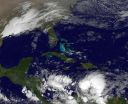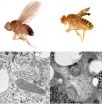(Press-News.org) The GOES-13 satellite keeps a continuous eye on the eastern half of the U.S. and Atlantic Ocean basin, and has provided meteorologists with an infrared look at a strengthening Tropical Storm Tomas this morning.
The Geostationary Operational Environmental Satellites like GOES-13 are managed by NOAA. The NASA GOES Project at NASA's Goddard Space Flight Center in Greenbelt, Md. creates images and animations from the GOES satellite data. When GOES-13 provided an infrared image (because it was taken at night) today, Nov. 2 at 0845 UTC (4:45 a.m. EDT), Tropical Storm Tomas showed a little more organization in its clouds after battling wind shear yesterday.
Infrared satellite data also showed that convection (rapidly rising air that form the thunderstorms that make up a tropical cyclone) has increased or deepened in Tomas. This morning most of that convection and thunderstorm activity is occurring over the eastern and northeastern areas around the center of circulation.
The wind shear over the south-central Caribbean Sea has weakened which has allowed Tomas to gradually re-strengthen. The waters are also much warmer than the 80 degree threshold needed to maintain or strengthen a tropical cyclone. Because of these improving conditions, the National Hurricane Center forecasts that Tomas will continue strengthening until Friday when an upper-level trough (elongated area of low pressure) will push Tomas north-northeastward toward the Windward Passage and parts of Hispaniola.
At 5 a.m. EDT, Tropical Storm Tomas had maximum sustained winds near 50 mph (up from 45 mph on Nov. 1). Tomas is moving west near 12 mph and has a minimum central pressure of 1003 millibars. The center of Tomas is located about 355 miles south of Port-au-Prince, Haiti near 13.5 North and 72.0 West. Tomas is being steered along the southern and southwestern edge of ridge (an elongated area) of high pressure which is moving Tomas west.
To visualize Tomas' movement, picture a penny on a table and move your finger from the bottom of the penny to the left. The penny is the area of high pressure, and your finger would be Tomas. High pressure areas act as a wall that tropical cyclones can't penetrate, so they move around the edges.
Tomas is forecast to become a hurricane on Thursday, Nov. 4 and turn to the northeast, threatening Haiti. Currently there are no watches and warnings in effect, but that's likely to change later this week.
INFORMATION:
GOES-13 catches Tropical Storm Tomas' early morning strengthening
2010-11-03
ELSE PRESS RELEASES FROM THIS DATE:
NJIT math professor illuminates cellular basis of neural impulse transmission
2010-11-03
NJIT Associate Professor Victor Matveev, PhD, in the department of mathematical sciences, was part of a research team that published "N-type Ca2+ channels carry the largest current: Implications for nanodomains and transmitter release," in Nature Neuroscience on Oct. 17, 2010. http://www.nature.com/neuro/journal/v13/n11/abs/nn.2657.html
Leading the project, Elise Stanley, PhD, a senior scientist at the Toronto Western Research Institute, said that Matveev's mathematical modeling showed that calcium influx through a single N-type calcium channel is sufficient to trigger ...
Improving health care in the Internet age
2010-11-03
Faster and more widely available internet access has improved our lives in many ways but healthcare is lagging behind, according to researchers writing in the International Journal of Medical Engineering and Informatics.
The US team suggests that there is immense potential for the utilization of digitized personal health records (PHR) in chronic disease management. They have reviewed the state of the art in healthcare portals, assessed the standardization and the legality of health record s and point to a need to improve interoperability, which still represents a major ...
New study re-examines bacterial vaccine studies conducted during 1918 influenza pandemic
2010-11-03
WHAT:
Secondary infections with bacteria such as Streptococcus pneumoniae, which causes pneumonia, were a major cause of death during the 1918 flu pandemic and may be important in modern pandemics as well, according to a new article in the Journal of Infectious Diseases co-authored by David M. Morens, M.D., senior advisor to the director of the National Institute of Allergy and Infectious Diseases, part of the National Institutes of Health.
The researchers examined 13 studies published between 1918 and 1920. During this time, many scientists erroneously believed that ...
Gastric bypass alters sweet taste function
2010-11-03
Gastric bypass surgery decreases the preference for sweet-tasting substances in obese rats, a study finding that could help in developing safer treatments for the morbidly obese, according to Penn State College of Medicine researchers.
"Roux-en-Y gastric bypass surgery is the most common effective treatment for morbid obesity," said Andras Hajnal, M.D., Ph.D., associate professor, Department of Neural and Behavioral Science and Surgery. "Many patients report altered taste preferences after having the procedure."
This surgery involves the creation of a small gastric ...
The Scientist's Life Science Salary Survey 2010 -- results announced
2010-11-03
This year's Salary Survey saw drops in salaries across the board with almost every speciality suffering a setback, some with dips as large as $20,000 (ecology) and $28,000 (virology).
However, a few select fields, namely bioinformatics, biophysics, biotechnology, and neuroscience, bucked the trend and actually posted salary increases this year. Whilst it is not easy to determine why these specialities saw salaries rise and others saw salaries cut, Mark Musen, head of the Stanford Center for Biomedical Informatics Research at Stanford University commented: "I've noticed ...
Antibody locks up West Nile's infection mechanism
2010-11-03
WEST LAFAYETTE, Ind. - Researchers have learned the structure that results when an antibody binds to the West Nile virus, neutralizing the virus by locking up its infection mechanism. The information could help scientists develop a vaccine against the mosquito-borne disease.
The findings show precisely how a key part of the antibody, called the antigen binding fragment, or Fab, attaches to two adjacent protein molecules that make up the virus's outer shell. This "crosslinking" attachment between molecules is repeated over the entire shell, interlocking the 30 molecular ...
Daily dose of beet juice promotes brain health in older adults
2010-11-03
Winston-Salem, N.C. – Researchers for the first time have shown that drinking beet juice can increase blood flow to the brain in older adults – a finding that could hold great potential for combating the progression of dementia.
The research findings are available online in Nitric Oxide: Biology and Chemistry, the peer-reviewed journal of the Nitric Oxide Society and will be available in print soon. (Read the abstract.)
"There have been several very high-profile studies showing that drinking beet juice can lower blood pressure, but we wanted to show that drinking beet ...
Severely injured should go directly to trauma center: Research
2010-11-03
TORONTO, Ont., Nov. 2, 2010-Severely injured patients should be transported directly from the scene of an accident to a trauma center, even if it means bypassing a closer hospital, according to new research that shows this results in a nearly 25 per cent lower death rate.
However, even though 80 to 85 per cent of people in North America live within a one-hour drive or flight of a trauma center, 30 to 60 per cent of severely injured patients are still taken to the nearest hospital.
Researchers led by Dr. Avery Nathens, trauma director at St. Michael's Hospital in Toronto, ...
Scientists at IRB Barcelona discover a new protein critical for mitochondria
2010-11-03
A study by the team headed by Lluís Ribas de Pouplana, ICREA professor at the Institute for Research in Biomedicine (IRB Barcelona), has been chosen as "Paper of the week" in the December issue of the Journal of Biological Chemistry, which is already available online. The article describes the discovery of a new protein in the fly Drosophila melanogaster (fruit fly) that is crucial for mitochondria. The removal of SLIMP in these flies leads to aberrant mitochondria and loss of metabolic capacity, thus causing death.
The study, whose first author is Tanit Guitart, a PhD ...
Brain's ability to selectively focus/pay attention diminishes with age
2010-11-03
A University of Toronto study shows that visual attention -- the brain's ability to selectively filter unattended or unwanted information from reaching awareness -- diminishes with age, leaving older adults less capable of filtering out distracting or irrelevant information.
Further, this age-related "leaky" attentional filter fundamentally impacts the way visual information is encoded into memory. Older adults with impaired visual attention have better memory for "irrelevant" information. The research, conducted by members of U of T's Department of Psychology, will ...

